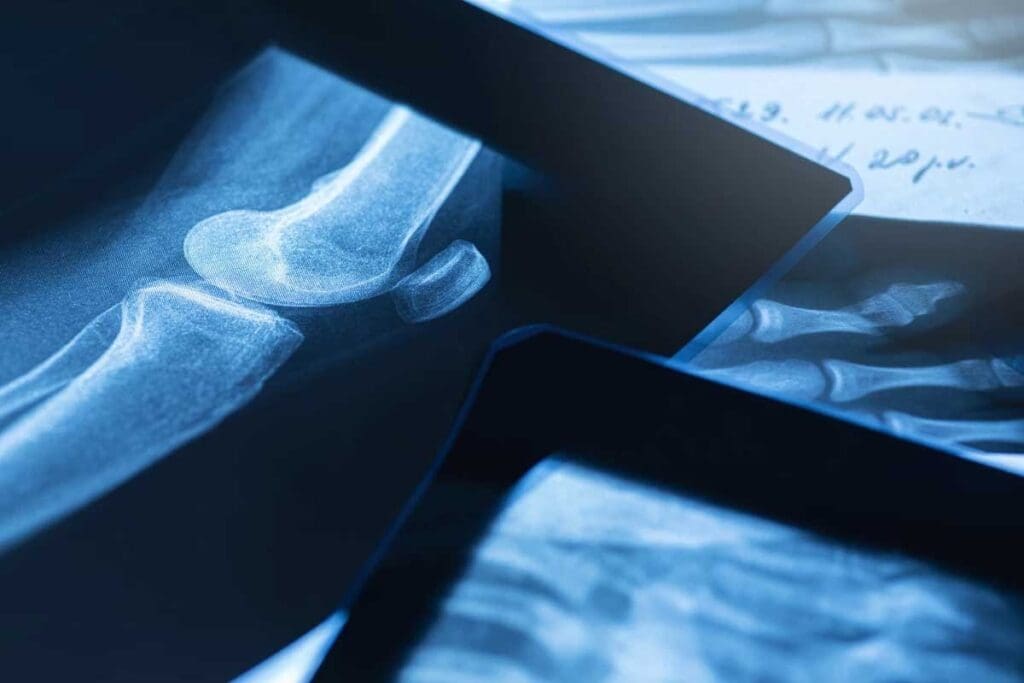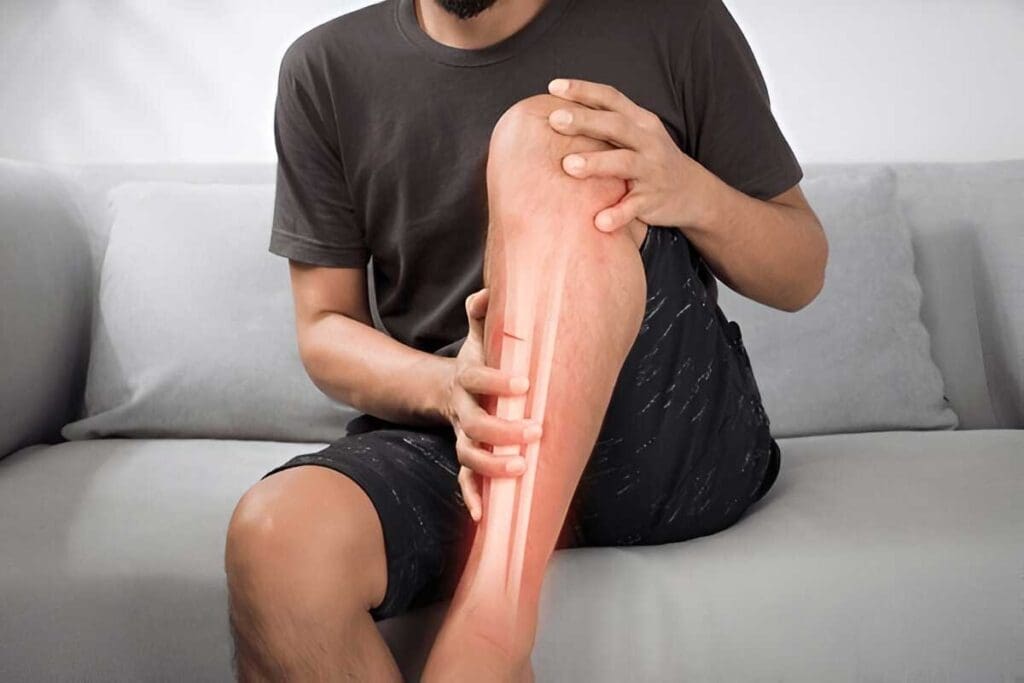Last Updated on November 20, 2025 by Ugurkan Demir

Ewing osteosarcoma is a very aggressive bone tumor. It mainly affects kids and teens. Knowing about its spread, stages, and how it’s likely to turn out is key for treatment. Early diagnosis and expert care can significantly improve outcomes for those dealing with this tough condition.
About 20-31% of patients have the tumor spread at first diagnosis. This shows the importance of quick and thorough care. Research shows that treatment has made a big difference. For nonmetastatic disease, the 5-year survival rate is now 75-80%. But, for metastatic disease, it’s a tougher fight with a survival rate of about 30%.

Ewing sarcoma, also known as Ewing osteosarcoma, is a very aggressive bone tumor. It mainly affects kids and teens. It’s caused by a specific genetic change, t(11;22), leading to the EWSR1-FLI1 fusion gene. This gene is key in how the tumor grows.
Ewing osteosarcoma starts from primitive neuroectodermal cells. But, where it comes from is not fully understood. The cells look small, round, and blue under a microscope. The EWSR1-FLI1 fusion gene is a big sign of this disease, found in about 85% of cases.
It’s important to tell Ewing osteosarcoma apart from other bone tumors. This is because of its unique genetic makeup and how it shows up in patients. Unlike osteosarcoma, Ewing sarcoma doesn’t have osteoid matrix.
To figure out if it’s Ewing osteosarcoma, doctors use imaging, look at tissue samples, and do genetic tests. Getting the right diagnosis is key to treating it well and helping patients get better.

Ewing sarcoma mainly hits kids and teens. It’s a rare cancer that grows fast. Most people get it when they’re young.
Ewing osteosarcoma mostly affects people between 10 and 20 years old. It’s rare in kids under 5 and adults over 30. The majority of cases are diagnosed during the teenage years.
More boys get Ewing sarcoma than girls. But why, we’re not sure. Research suggests that genetic factors may play a role in this cancer.
We don’t know what causes Ewing osteosarcoma. But some genes are linked to it. The EWS/FLI1 fusion gene is the most common.
Other things might increase your risk, like some toxins or radiation. But most cases occur without a known risk factor. This shows we need more research.
Knowing who’s at risk helps doctors catch it early. This way, they can treat it better. It’s all about spotting it early and treating it right.
Ewing osteosarcoma is hard to diagnose because its early signs are not clear. It can look like other diseases, making it hard to catch early.
The first signs of Ewing osteosarcoma include bone pain, swelling, and sometimes fever and weight loss. These symptoms are not specific and can be confused with other bone problems.
Common symptoms include:
To diagnose Ewing osteosarcoma, doctors use imaging and a biopsy. X-rays, MRI, and CT scans help find and size the tumor.
A biopsy is done to check the tumor cells. This step is key to confirming the diagnosis and ruling out other bone cancers.
When diagnosing Ewing osteosarcoma, doctors also consider other bone cancers. Getting the right diagnosis is vital for choosing the right treatment.
| Differential Diagnosis | Key Distinguishing Features |
| Osteosarcoma | Produces osteoid, more common in older adults |
| Rhabdomyosarcoma | Muscle origin, different immunohistochemical markers |
| Lymphoma | Lymphoid origin, distinct histological features |
Knowing these differences is key to making an accurate diagnosis and planning the best treatment.
It’s key to know how Ewing sarcoma spreads to develop good treatments. This bone tumor mainly hits kids and teens. When it spreads at first, it changes how well a patient can be treated.
About 20-31% of Ewing sarcoma patients have spread at first diagnosis. This spread greatly affects how long they might live and their treatment. Spotting it early and knowing how far it’s spread is key to the right treatment.
Ewing sarcoma often spreads to the lungs and bones. Lungs are a big problem, needing strong treatments. Bones can spread anywhere but often hit the spine and pelvis. When it spreads to these places, treatment gets harder and might need more than one approach.
Finding where Ewing sarcoma has spread involves imaging and biopsies. CT scans, PET scans, and MRI help see how far it’s gone. Knowing this helps doctors plan the best treatment.
In short, knowing how Ewing sarcoma spreads is key to treating it well. How common it is to spread at first, where it goes, and how to find it all affect treatment plans and patient outcomes.
Ewing osteosarcoma staging is complex. It looks at many factors to guess how well a patient will do. The staging system is key for doctors to know how far the disease has spread. This helps them plan the best treatment.
The TNM classification is a common way to stage Ewing sarcoma. It considers the size and spread of the tumor (T), nearby lymph nodes (N), and if the cancer has spread metastasis (M). This system helps doctors understand how serious the disease is.
The National Cancer Institute says, “The TNM staging system is key for knowing how well a patient will do and what treatment they need.”
“The TNM system is a critical tool in oncology, allowing for standardized classification of cancer severity.”
Ewing osteosarcoma is split into two types: localized and metastatic. Localized disease means the cancer is only at the original site. Metastatic disease means it has spread to other parts of the body. Knowing this helps doctors predict how well a patient will do and what treatment is best.
The size and where the tumor is matter a lot in Ewing osteosarcoma staging. Bigger tumors and those in the head or spine are usually riskier. The staging system looks at these factors to give a better idea of the disease’s severity.
A study in the Journal of Clinical Oncology found, “Tumor size and location are key to predicting outcomes in Ewing sarcoma patients.” Accurate staging helps doctors find the right treatments for each patient.
Several key factors affect the prognosis of Ewing osteosarcoma. These factors help shape the treatment plan and patient outcomes. It’s important for doctors to understand these factors to make better decisions. Patients also need to know what to expect.
Tumor size is a big factor in Ewing osteosarcoma. Tumors over 8cm have a worse prognosis than smaller ones. Tumors in the pelvis or spine are harder to remove and often have a poorer outcome.
Key considerations for tumor size and location include:
Metastasis at diagnosis greatly affects Ewing osteosarcoma prognosis. Patients with metastasis, and even more so with widespread disease, face a poorer prognosis than those without.
Metastasis detection involves:
The response to neoadjuvant chemotherapy is a key indicator. Patients with more than 90% tumor necrosis after chemotherapy have a better prognosis than those with less response.
Factors influencing response to neoadjuvant therapy include:
New research has found molecular and genetic markers that help predict outcomes. Certain genetic fusions, like EWS-FLI1, are specific to Ewing sarcoma and can affect prognosis.
Understanding these critical factors is essential for managing Ewing osteosarcoma. By looking at tumor size, location, metastasis, therapy response, and molecular markers, doctors can tailor treatments for better results.
It’s important to know the survival rates and how outcomes differ for Ewing osteosarcoma. The 5-year survival rates for Ewing’s sarcoma vary a lot. They range from 70-80% for those with localized disease to less than 30% for those with metastatic disease.
The outlook for patients with ewings sarcoma depends on several things. These include the tumor’s size, location, and how well it responds to initial treatment. Patients with erwin sarcoma or ewings tumour who have metastatic disease at diagnosis have a worse outlook than those with localized disease.
Thanks to new treatments and team-based care, outcomes for Ewing osteosarcoma patients have gotten better. But, there are differences in outcomes that need to be addressed. This shows we need to keep researching and improving care to help all patients with ewings sarcoma survive longer.
Ewing osteosarcoma is a rare and aggressive bone cancer. It mainly affects kids and teens. It’s caused by a specific genetic change.
Symptoms include pain, swelling, and trouble moving the affected area. You might also feel feverish or lose weight.
Doctors use X-rays, MRI, and CT scans to find the cancer. A biopsy confirms it. The EWSR1-FLI1 gene is a key sign.
When the cancer spreads, it gets worse. It often goes to the lungs, bones, and bone marrow. Finding this spread is important for treatment.
Staging looks at the tumor’s size, where it is, and if it has spread. This helps decide the best treatment.
Important factors include tumor size, where it is, and if it has spread. How well it responds to early treatment also matters.
The outlook depends on the stage, tumor details, and treatment response. Modern treatments have improved survival rates, but outcomes vary.
Yes, Ewing’s sarcoma is cancerous. It can grow and spread to other parts of the body.
It mostly affects kids and teens. Most cases happen between 10 and 20 years old.
It has unique cells and the EWSR1-FLI1 gene. This makes it different from other bone cancers like osteosarcoma.
Subscribe to our e-newsletter to stay informed about the latest innovations in the world of health and exclusive offers!